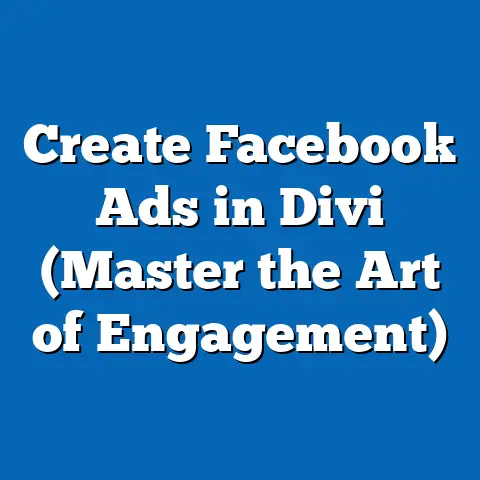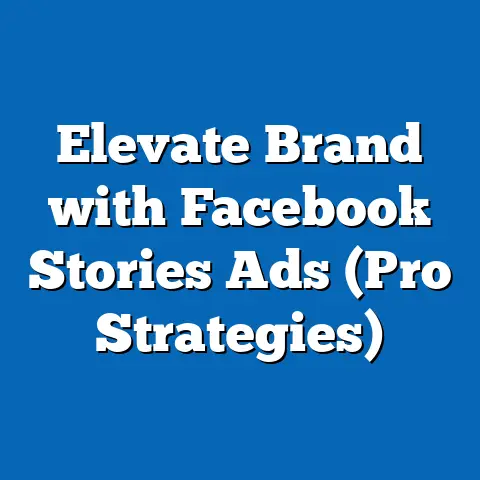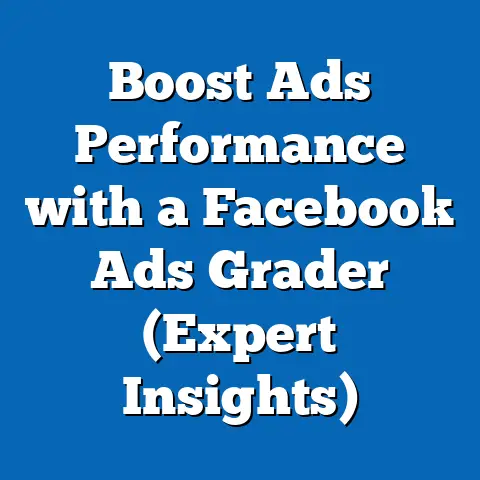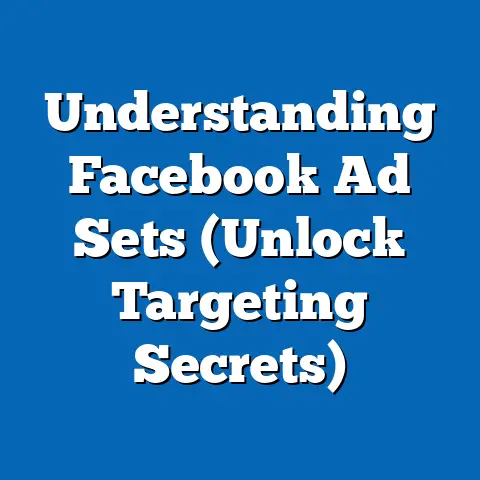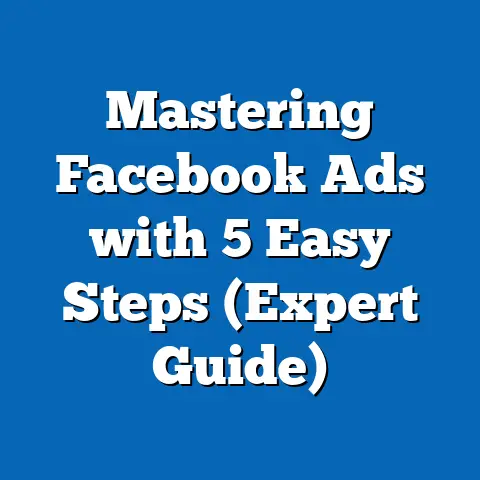Maximize Music Reach with Facebook Ads (Pro Tips)
Music. It’s more than just sound; it’s emotion, connection, and a universal language that transcends borders. As a musician myself, I know firsthand the passion and dedication that goes into crafting a song, an album, a career. But in today’s digital age, creating amazing music is only half the battle. You need to get it heard! And that’s where Facebook ads come in.
Forget the old days of expensive radio spots and glossy magazine ads. Facebook advertising offers a powerful, cost-effective way for musicians and music promoters to connect with potential listeners. We’re talking about reaching a targeted audience, building a fanbase, and driving streams – all without emptying your bank account.
Think about it: Facebook boasts billions of active users, many of whom are actively seeking out new music. According to Statista, over 1.96 billion people use Facebook every day, and a significant portion of them are engaging with music-related content. This creates a massive opportunity for artists, both independent and signed, to tap into a highly engaged audience.
The beauty of Facebook ads lies in its affordability. Unlike traditional advertising methods that can cost thousands of dollars, you can start with a budget as low as $5 a day and still see meaningful results. This makes it an incredibly accessible tool for independent artists and small labels who are often operating on tight budgets.
I’ve seen this firsthand! I remember when I was first starting out, I had a shoestring budget and desperately needed to get my music out there. I experimented with Facebook ads and was amazed at how targeted I could be. I reached people who genuinely enjoyed my genre, and the engagement was incredible. It was a game-changer!
My goal is to empower you with the knowledge and strategies you need to turn Facebook into a powerful promotional tool, helping you reach new fans, grow your audience, and share your music with the world. Let’s dive in!
Understanding Your Audience
One of the biggest mistakes I see musicians make with Facebook ads is failing to properly target their audience. It’s like throwing a dart at a board blindfolded – you might hit something, but it’s unlikely to be what you were aiming for.
Audience targeting is the cornerstone of successful music promotion on Facebook. You need to know who your ideal listeners are, what they like, and where they spend their time online. The more specific you are, the more likely you are to reach people who will actually connect with your music.
Fortunately, Facebook provides a wealth of tools to help you understand your audience. The most powerful of these is Facebook Audience Insights. This free tool allows you to gather data on potential listeners based on a variety of factors, including:
- Demographics: Age, gender, location, education level, relationship status, job title.
- Interests: Hobbies, activities, pages they like, topics they engage with.
- Behaviors: Purchase history, device usage, travel habits, online activities.
I remember using Audience Insights for a client who was a blues musician. We initially thought his target audience was older men, but the data revealed that a significant portion of his listeners were actually younger women interested in vintage fashion and retro culture. This insight completely changed our ad strategy and led to a much more successful campaign.
Here’s how you can use Audience Insights to find your ideal music audience:
- Start with your existing fans: Analyze your Facebook page followers, email subscribers, and streaming platform data to identify common characteristics.
- Explore related artists and genres: Use Audience Insights to see who is interested in similar artists or genres. This can help you discover new potential audiences.
- Consider lifestyle factors: Think about the lifestyle of your ideal listener. What other products or services do they use? What are their values and beliefs?
- Refine your targeting: Use the data you gather to create highly targeted ad audiences based on specific demographics, interests, and behaviors.
Key Demographics for Music Audiences:
- Age: Different age groups have different musical tastes. Are you targeting teenagers, young adults, or an older demographic?
- Location: Where are your fans located? Are they concentrated in specific cities, states, or countries?
- Interests: What other artists, genres, or topics are they interested in?
- Behaviors: What types of music do they listen to online? Do they attend concerts or music festivals?
Creating Buyer Personas:
Once you’ve gathered data on your potential listeners, it’s helpful to create buyer personas. These are fictional representations of your ideal customers, based on research and data. A buyer persona will help you to tailor your ad content to resonate with specific audiences.
For example, you might create a persona named “Indie Music Enthusiast Emily.” Emily is a 24-year-old college graduate living in a major city. She loves discovering new indie bands and attending local concerts. She’s active on social media and follows several music blogs and influencers.
By creating a detailed persona like Emily, you can better understand her needs, motivations, and pain points. This will help you craft ad copy and creatives that speak directly to her and encourage her to check out your music.
Tailoring Ad Content:
The key to successful audience targeting is to tailor your ad content to resonate with each specific audience segment. This means creating different ads with different messaging and visuals that appeal to different groups of people.
For example, if you’re targeting young adults, you might use more modern language, trendy visuals, and a focus on social media sharing. If you’re targeting an older demographic, you might use more traditional language, classic visuals, and a focus on nostalgia.
Takeaway: Understanding your audience is crucial for successful music promotion on Facebook. Use Facebook Audience Insights to gather data on potential listeners, create buyer personas, and tailor your ad content to resonate with specific audience segments. This will help you reach the right people and get your music heard by those who will truly appreciate it.
Next Step: Spend some time exploring Facebook Audience Insights and gathering data on your potential listeners. Create at least three buyer personas based on your research.
Crafting Compelling Ads
Okay, you’ve nailed down your audience, now what? Now comes the fun part: creating ads that grab attention, spark interest, and ultimately, get people listening to your music. In my experience, a compelling Facebook ad is a combination of eye-catching visuals, persuasive copy, and a clear call to action.
Visual Appeal:
In the fast-paced world of social media, visuals are king. Your ad needs to stand out from the noise and capture attention within seconds. That means using high-quality images and videos that are visually appealing and relevant to your music.
- High-Quality Images: Use professional-looking photos of yourself or your band. Avoid blurry or pixelated images.
- Engaging Videos: Short, engaging videos are incredibly effective for promoting music. Consider using snippets of your music videos, live performances, or behind-the-scenes footage.
- Album Art: Use your album art as a visual element in your ad. This is a great way to promote new releases.
- Consider Ad Design: I’ve found that a well-designed ad with appropriate color palettes and fonts resonates well with the audience.
Ad Copy that Captures Attention:
Your ad copy is your chance to tell your story and convince people to check out your music. Keep it concise, engaging, and relevant to your target audience.
- Headline: Use a catchy headline that grabs attention and conveys the main message of your ad.
- Description: Write a short, compelling description that highlights the unique aspects of your music.
- Storytelling: Share a personal story or anecdote that connects with your audience on an emotional level.
- Social Proof: Include testimonials or reviews from other listeners to build credibility.
I remember working with a folk musician who was struggling to get his music heard. We created an ad featuring a simple, heartfelt video of him playing his guitar in a park. The ad copy focused on the emotional connection people feel when listening to his music. The result was a huge surge in streams and a loyal following of fans who were genuinely moved by his music.
Examples of Successful Ad Creatives:
- Indie Rock: A visually striking photo of the band performing live, with ad copy that highlights their unique sound and upcoming tour dates.
- Hip Hop: A short, energetic video showcasing the artist’s latest music video, with ad copy that emphasizes the catchy beats and lyrical prowess.
- Electronic Music: A visually stunning animated video synced to the artist’s music, with ad copy that invites listeners to experience the immersive soundscape.
- Classical Music: A serene photo of the orchestra performing, with ad copy that highlights the beauty and tranquility of the music.
The Power of a Clear Call-to-Action (CTA):
Don’t leave your audience guessing! Tell them exactly what you want them to do. Your call-to-action should be clear, concise, and compelling.
- Listen Now: Use this CTA to encourage people to stream your music on Spotify, Apple Music, or other platforms.
- Download Now: Use this CTA to promote your music on platforms like iTunes or Bandcamp.
- Learn More: Use this CTA to drive traffic to your website or landing page where people can learn more about you and your music.
- Follow: Use this CTA to build your fan base on Facebook, Instagram, or other social media platforms.
- Buy Tickets: Use this CTA to promote your upcoming concerts or events.
Testing Different Ad Formats:
Facebook offers a variety of ad formats, each with its own strengths and weaknesses. It’s important to test different formats to see what resonates best with your audience.
- Carousel Ads: Showcase multiple images or videos in a single ad. This is a great way to highlight different aspects of your music or promote multiple songs.
- Video Ads: As I mentioned before, videos are incredibly engaging. Use short, compelling videos to capture attention and tell your story.
- Image Ads: Simple image ads can be effective if you use high-quality visuals and compelling ad copy.
- Collection Ads: These ads are great for showcasing a collection of products, such as your albums, merchandise, and concert tickets.
I’ve found that A/B testing is invaluable here. Create two versions of an ad, changing only one element (e.g., the headline, the image, the CTA). Run both ads simultaneously and see which one performs better. This will help you to optimize your ads for maximum impact.
Takeaway: Crafting compelling Facebook ads is a blend of art and science. Use high-quality visuals, persuasive copy, and a clear call-to-action to capture attention and get people listening to your music. Don’t be afraid to experiment with different ad formats and A/B test your ads to optimize performance.
Next Step: Create at least three different ad creatives for your music, using different visuals, ad copy, and CTAs. Be prepared to A/B test these ads to see which ones perform best.
Budgeting for Success
One of the biggest misconceptions about Facebook advertising is that you need a huge budget to see results. That’s simply not true! In fact, one of the biggest advantages of Facebook ads is its flexibility. You can start with a small budget and gradually increase it as you see results.
I’ve worked with artists who have achieved significant success with budgets as low as $5 a day. The key is to be strategic and focus on targeting the right audience with the right message.
Flexible Pricing Structure:
Facebook ads operate on a bidding system. You set a budget and bid for ad placements. The higher your bid, the more likely your ad is to be shown to your target audience. However, you don’t necessarily need to bid the highest to win. Facebook also considers the quality and relevance of your ad when determining which ads to show.
Bidding Strategies:
Facebook offers several different bidding strategies, each with its own advantages and disadvantages.
- Cost-Per-Click (CPC): You pay each time someone clicks on your ad. This is a good strategy if your goal is to drive traffic to your website or landing page.
- Cost-Per-Impression (CPM): You pay for every 1,000 times your ad is shown. This is a good strategy if your goal is to increase brand awareness.
- Cost-Per-Action (CPA): You pay only when someone takes a specific action, such as listening to your music, downloading your album, or signing up for your email list. This is the most targeted strategy but may require a larger budget.
Choosing the Right Bidding Strategy:
The best bidding strategy for you will depend on your goals and budget. If you’re just starting out, I recommend using CPC or CPM. These strategies allow you to test different ads and audiences without spending a lot of money. As you gain more data and experience, you can consider switching to CPA.
Setting a Daily or Lifetime Budget:
Facebook allows you to set either a daily budget or a lifetime budget for your ad campaigns.
- Daily Budget: This is the average amount you’re willing to spend each day on your ads. Facebook will try to spend this amount each day, but it may fluctuate slightly.
- Lifetime Budget: This is the total amount you’re willing to spend on your ads over the entire duration of the campaign. Facebook will try to distribute your budget evenly over the campaign period.
I typically recommend starting with a daily budget. This allows you to monitor your ad spend more closely and make adjustments as needed.
Tips for Setting a Budget:
- Start Small: Begin with a small budget and gradually increase it as you see results.
- Consider Your Goals: Set a budget that aligns with your goals. If you’re trying to reach a large audience, you’ll need a larger budget than if you’re targeting a small, niche audience.
- Monitor Your Ad Spend: Keep a close eye on your ad spend and make adjustments as needed. If you’re not seeing the results you want, try tweaking your targeting, ad creative, or bidding strategy.
Monitoring Ad Spend:
It’s crucial to monitor your ad spend and adjust your campaigns based on performance metrics. Facebook provides a variety of metrics to help you track your ad performance, including:
- Impressions: The number of times your ad was shown.
- Reach: The number of unique people who saw your ad.
- Clicks: The number of times people clicked on your ad.
- Click-Through Rate (CTR): The percentage of people who saw your ad and clicked on it.
- Cost-Per-Click (CPC): The average amount you paid for each click.
- Cost-Per-Impression (CPM): The average amount you paid for every 1,000 impressions.
- Conversions: The number of people who took a desired action, such as listening to your music, downloading your album, or signing up for your email list.
- Cost-Per-Conversion: The average amount you paid for each conversion.
By tracking these metrics, you can identify which ads are performing well and which ones need to be tweaked or eliminated.
Takeaway: Budgeting for success on Facebook ads doesn’t require a fortune. Start small, choose the right bidding strategy, set a realistic budget, and monitor your ad spend closely. By being strategic and data-driven, you can achieve significant results with a relatively small investment.
Next Step: Determine your budget for your Facebook ad campaign. Choose a bidding strategy and set a daily or lifetime budget. Commit to monitoring your ad spend and making adjustments as needed.
Utilizing Facebook Ad Tools
Facebook Ad Manager is your command center for creating, managing, and optimizing your ad campaigns. It’s a powerful tool that can help you achieve your music promotion goals, but it can also be a bit overwhelming at first.
I remember when I first started using Ad Manager, I felt like I was navigating a maze. But with a little practice and guidance, I quickly learned how to use it to my advantage.
Exploring Facebook Ad Manager:
Ad Manager provides a variety of features to help you optimize your ad campaigns. Here are some of the most important:
- Campaign Creation: This is where you create new ad campaigns, set your goals, and choose your target audience.
- Ad Set Creation: This is where you define your budget, bidding strategy, and ad schedule.
- Ad Creation: This is where you create your ad creative, including the visuals, ad copy, and call-to-action.
- Reporting: This is where you track your ad performance and analyze your results.
Setting Up a Facebook Pixel:
The Facebook Pixel is a small piece of code that you can install on your website. It allows Facebook to track conversions and gather data on audience interactions. This data can be used to optimize your ad campaigns and target your ads more effectively.
For example, if you’re selling music on your website, the Facebook Pixel can track which ads are driving sales. This information can help you to identify your most effective ads and allocate your budget accordingly.
Benefits of Using A/B Testing:
A/B testing, as I mentioned before, is a powerful technique for optimizing your ad performance. By creating two versions of an ad and running them simultaneously, you can see which one performs better. This will help you to identify which elements of your ad are most effective and make data-driven decisions about how to improve your campaigns.
Scheduling Ads:
Facebook allows you to schedule your ads to run at specific times of day or on specific days of the week. This can be a useful strategy for maximizing your reach during peak engagement times.
For example, if you know that your target audience is most active on Facebook in the evenings, you can schedule your ads to run during those hours. This will increase the likelihood that your ads will be seen by your target audience.
Utilizing Facebook’s Automated Features:
Facebook offers a variety of automated features that can help you optimize your ad campaigns. These features include:
- Automated Bidding: Facebook can automatically adjust your bids to maximize your results within your budget.
- Dynamic Creative: Facebook can automatically generate different versions of your ad creative based on your target audience.
- Lookalike Audiences: Facebook can create new audiences that are similar to your existing customers or fans.
These automated features can save you time and effort while helping you to improve your ad performance.
Takeaway: Facebook Ad Manager is a powerful tool that can help you achieve your music promotion goals. Explore its features, set up a Facebook Pixel, use A/B testing to optimize your ads, schedule your ads to run during peak engagement times, and utilize Facebook’s automated features to maximize your reach.
Next Step: Spend some time exploring Facebook Ad Manager and familiarizing yourself with its features. Set up a Facebook Pixel on your website and experiment with A/B testing.
Engaging with the Audience
Creating great ads is only part of the equation. The other part is engaging with your audience and building a community around your music. Facebook is a social platform, so it’s important to be social!
I’ve seen artists transform their Facebook pages from simple promotional tools into thriving communities where fans connect with each other and with the artist on a personal level.
The Importance of Engagement:
Engaging with your audience can help you to:
- Build Relationships: Connect with your fans on a personal level and build lasting relationships.
- Increase Brand Loyalty: Create a loyal fan base that will support your music for years to come.
- Drive Word-of-Mouth Marketing: Encourage your fans to share your music with their friends and family.
- Improve Ad Performance: Facebook rewards ads that generate high engagement with lower costs and better reach.
Strategies for Engaging with the Audience:
- Respond to Comments and Messages: Take the time to respond to comments and messages from your fans. This shows that you care about their opinions and are willing to engage with them.
- Ask Questions: Ask your fans questions about their favorite music, concerts, or experiences. This will encourage them to participate in the conversation.
- Share Behind-the-Scenes Content: Give your fans a glimpse into your life as a musician. Share behind-the-scenes photos and videos of your recording sessions, rehearsals, and performances.
- Run Contests and Giveaways: Offer your fans the chance to win prizes, such as concert tickets, merchandise, or signed albums.
- Go Live: Use Facebook Live to connect with your fans in real-time. Perform live music, answer questions, or simply chat with your audience.
Leveraging User-Generated Content:
User-generated content (UGC) is content created by your fans, such as photos, videos, and reviews. UGC can be a powerful tool for promoting your music and building your brand.
Encourage your fans to share their own content related to your music. You can do this by:
- Asking them to tag you in their photos and videos.
- Running contests that encourage them to create UGC.
- Featuring UGC on your Facebook page.
Creating a Community:
One of the best ways to engage with your audience is to create a community around your music. You can do this by creating a Facebook Group or Event.
- Facebook Group: A Facebook Group is a private space where your fans can connect with each other and with you. You can use a Facebook Group to share exclusive content, run contests, and host discussions.
- Facebook Event: A Facebook Event is a great way to promote your upcoming concerts or events. You can use a Facebook Event to share details about the event, sell tickets, and connect with attendees.
The Role of Live Videos and Interactive Posts:
Live videos and interactive posts are incredibly engaging and can help you to increase your reach and ad visibility.
- Live Videos: As I mentioned before, live videos are a great way to connect with your fans in real-time.
- Interactive Posts: Interactive posts, such as polls, quizzes, and Q&A sessions, can encourage your fans to participate in the conversation and engage with your content.
Takeaway: Engaging with your audience is crucial for building a loyal fan base and promoting your music effectively. Respond to comments and messages, ask questions, share behind-the-scenes content, run contests and giveaways, go live, leverage user-generated content, and create a community around your music.
Next Step: Commit to engaging with your audience on a regular basis. Respond to comments and messages, ask questions, and share behind-the-scenes content. Consider creating a Facebook Group or Event to build a community around your music.
Conclusion
So, we’ve covered a lot of ground, haven’t we? From understanding your audience to crafting compelling ads, budgeting for success, utilizing Facebook ad tools, and engaging with your fans, you now have a solid foundation for maximizing your music reach affordably through Facebook ads.
I truly believe that Facebook advertising offers an incredible opportunity for musicians and music promoters to connect with potential listeners, build a fanbase, and drive streams – all without breaking the bank. The key is to approach it strategically, armed with the knowledge and tools you need to succeed.
Remember, the affordability of Facebook ads makes it an accessible tool for independent artists and small labels who are often operating on tight budgets. But simply throwing money at Facebook ads isn’t enough. You need to:
- Understand Your Audience: Know who your ideal listeners are, what they like, and where they spend their time online.
- Craft Compelling Ads: Use high-quality visuals, persuasive copy, and a clear call-to-action to capture attention and get people listening to your music.
- Budget for Success: Start small, choose the right bidding strategy, set a realistic budget, and monitor your ad spend closely.
- Utilize Facebook Ad Tools: Explore the features of Facebook Ad Manager, set up a Facebook Pixel, use A/B testing to optimize your ads, and utilize Facebook’s automated features.
- Engage with the Audience: Respond to comments and messages, ask questions, share behind-the-scenes content, run contests and giveaways, go live, leverage user-generated content, and create a community around your music.
I encourage you to take action today! Don’t let your music sit on a hard drive, unheard and unappreciated. Harness the power of Facebook ads to build your audience, share your music with the world, and achieve your musical dreams.
So, go out there, create some amazing ads, engage with your fans, and let the world hear your music! The stage is set, the spotlight is on, and the audience is waiting. It’s your time to shine!


